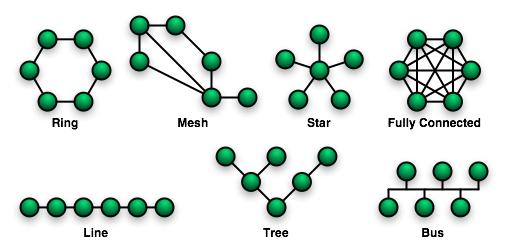• Point-to-point - one line connecting two locations
• Multipoint - one line connecting more than two sites together, also referred to as multidrop
• Star (hub and spoke) configuration - all locations connect to, or "hub into," a central site. PBXs and data switches in LANs are configured in star topologies. If the main location in a star configuration goes down, all nodes (locations) on the network are out of services.
• Mesh design - all points on the network, nodes, connect to each other in a flat or nonhierarchical manner. If one link in a mesh network is out of service, traffic can be rerouted over other links. Peer-to-peer networks for music sharing are examples of mesh networks. Most wireless community networks based on 802.11 technology use a form of mesh design called partial mesh in which access points with antennas are connected to each other. In partial mesh designs, not all end-user devised are connected to each other.

Image Source: http://upload.wikimedia.org/wikipedia/commons/9/96/NetworkTopologies.png
For more information about network topologies (and about more topologies) visit: http://en.wikipedia.org/wiki/Network_topologies.
For more information about network topologies (and about more topologies) visit: http://en.wikipedia.org/wiki/Network_topologies.



No comments:
Post a Comment